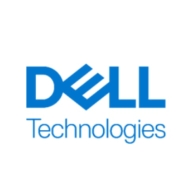


Hitachi Virtual Storage Platform and Dell PowerStore are leading storage solutions in the IT industry. Hitachi appears to have the upper hand in performance and scalability, while Dell is noted for its integration and support capabilities.
Features: Users value Hitachi Virtual Storage Platform for high performance, efficient scalability, and robust performance suitable for heavy workloads. Dell PowerStore is recognized for its flexibility, excellent integration capabilities, and adaptability to various IT environments.
Room for Improvement: Hitachi users suggest improvements in provisioning, automation features, and user interface simplicity. Dell users point to software stability, advanced analytics, and optimization of update processes.
Ease of Deployment and Customer Service: Hitachi's deployment process is complex but aided by effective customer support. Dell PowerStore offers smoother deployment and easier integration. Both offer strong customer service, with Dell being more user-friendly in deployment.
Pricing and ROI: Hitachi Virtual Storage Platform involves significant upfront costs but offers a high ROI due to reliable performance. Dell PowerStore features competitive pricing and quicker ROI due to efficient resource utilization.
If you wait more than seven years to buy another one, you get a return on your investment.
If you purchase storage with 300 terabytes, you can easily achieve one petabyte of effective capacity.
It's been trouble-free the entire time, with very high performance, as it has been designed and built properly.
We have seen a return on our investment in Dell PowerStore; definitely our cost per terabyte has been very good compared to some of the other vendors that we would have been using previously, and our performance benchmarks have exceeded what we were expecting.
While performance, security, and financial aspects of Hitachi Virtual Storage Platform are satisfactory, I am unsure about the exact return on investment.
Customers always have their issues resolved promptly.
Technical support is good at least through vendors, not directly with the principal.
I would rate the technical support of Dell PowerStore between nine and ten out of ten.
They're responsive, knowledgeable, and have a quick turnaround.
On a scale of one to ten, I would rate Dell support as a ten, focusing on that aspect alone, because it's what allows me to sleep at night.
The time taken to act upon issues is quite large, and issue identification takes a significant amount of time, especially when it comes to critical problems.
It hasn't broken down anytime in the last six to seven years, despite hurricanes, earthquakes, and power outages.
The solution's scalability is a ten out of ten.
It scales up and scales out both ways, and as our data keeps growing, it is very easy to just keep attaching and keep growing.
Scaling up can be done from a single enclosure that already has two controllers to a maximum of four storage units with up to eight controllers, and a massive amount of storage can be added.
I would rate the stability of the product at seven out of ten.
When I removed all the cables, it failed over within five minutes.
It's quite stable and reliable in general.
There are no bugs or glitches and it doesn't crash or freeze.
If we are running on a standalone infrastructure, I would rate Hitachi Virtual Storage Platform a 10 for stability.
One way to improve the product is to add an operational assistant that doesn't depend on VMware.
I would like to see some AI features that would allow arrays to intelligently identify threats or unusual behavior in the data pattern and give an alert.
Storage replication should be essential.
Something needs to be done with the caching to ensure that if some issue occurs, there needs to be an ability to disable caching during maintenance to make it static, safe, and good.
Pricing must also be considered, as Dell PowerStore is quite expensive compared to competitors in the market like HPE Alletra, Huawei Dorado, or Hitachi storage, for example.
The main reason why people move to Pure Storage is because it's simplified.
The interface management and monitoring need improvement.
Additional functionality related to data encryption and authentication could improve Hitachi Virtual Storage Platform.
While the prices may be higher than those of other vendors, we see it as a market leader with benefits.
The support can be a bit pricey, but the solution is more cost-effective than anything else out there.
Likely the cost is $400,000 whereas IBM may be $250,000.
Based on my experience, the cost of Dell PowerStore for around 500 GB of capacity is very competitive compared to any other platform in the market.
I asked for a new quotation on a server, and it is quite expensive; it is really expensive.
The cost of Hitachi Virtual Storage Platform is reasonable compared to competitors.
Its data compression feature is the best that we have ever seen.
Pure FlashArray X NVMe helps to improve our processing speed.
We are satisfied with the performance as it is significantly faster compared to traditional storage options.
This includes storage sharing, adding servers to the service, and the wireless host connection on the network side.
Dell PowerStore offers good integration capabilities, especially since it helps with backup, which is an important aspect.
In terms of whether my company could reduce the power consumption with Dell PowerStore, I would say that my company had a use case with a customer around three weeks ago where their old Dell EMC VNX Storage System used to draw about 2500 watts compared to Dell PowerStore which drew about 800 watts, which is a really a big saving looking at the twenty-four hours and seven days of usage of the system.
The active data management of Hitachi Virtual Storage Platform, especially with the HOPS Center, makes it easier to work with the Hitachi Virtual Storage Platform infrastructure.
Hitachi Virtual Storage Platform is a great device that is very stable, very durable, and very simple.

| Company Size | Count |
|---|---|
| Small Business | 15 |
| Midsize Enterprise | 11 |
| Large Enterprise | 12 |
| Company Size | Count |
|---|---|
| Small Business | 49 |
| Midsize Enterprise | 33 |
| Large Enterprise | 74 |
| Company Size | Count |
|---|---|
| Small Business | 19 |
| Midsize Enterprise | 15 |
| Large Enterprise | 28 |
Pure Storage FlashArray//X is the world’s first enterprise-class, all-NVMe flash storage array. It represents a new class of storage – shared accelerated storage, which is a term coined by Gartner – that delivers major breakthroughs in performance, simplicity, and consolidation.
Dell PowerStore is a scalable, high-performance platform supporting both modern and traditional workloads, enhancing IT operations with AI-driven automation and advanced data reduction features.
Designed for flexibility, Dell PowerStore integrates seamlessly with VMware, providing robust security and high IOPS. Users benefit from fast NVMe storage, intelligent data management, and scalable performance to handle diverse workload demands. However, improvements are needed in replication, enterprise functionalities, and UI complexity. Stability and support issues highlight the need for enhanced monitoring and pricing strategies.
What are the key features of Dell PowerStore?
What benefits does Dell PowerStore offer?
In industries like finance, healthcare, and IT, Dell PowerStore is critical for VMware virtualization, high-performance databases, and backup storage. It supports hosting virtual machines, mirroring storage, and handling SAP and Oracle databases effectively. Its role in hybrid and on-premises setups showcases its adaptability and integration capabilities for mission-critical tasks.
RETHINK YOUR DEFINITION OF SPEED AND PERFORMANCE
With adaptive, guaranteed data reduction and a 100% data-availability guarantee, Hitachi Virtual Storage Platform F series helps you tackle complicated business challenges. Hitachi Data Systems (HDS) VSP F series delivers up to 4.8M IOPS with sub-millisecond response times.
Featuring legendary Hitachi reliability, VSP F series arrays are backed by the industries only 100% availability guarantee. For these reasons, 80% of the Fortune 500 choose Hitachi all-flash arrays to accelerate the performance of mission-critical applications like Oracle, SAP, Virtualization, Microsoft apps etc. With over 350 patents in flash technology, Hitachi’s innovative mix of flash hardware and software accelerates ROI with enterprise-class reliability and performance.
We monitor all NAS reviews to prevent fraudulent reviews and keep review quality high. We do not post reviews by company employees or direct competitors. We validate each review for authenticity via cross-reference with LinkedIn, and personal follow-up with the reviewer when necessary.